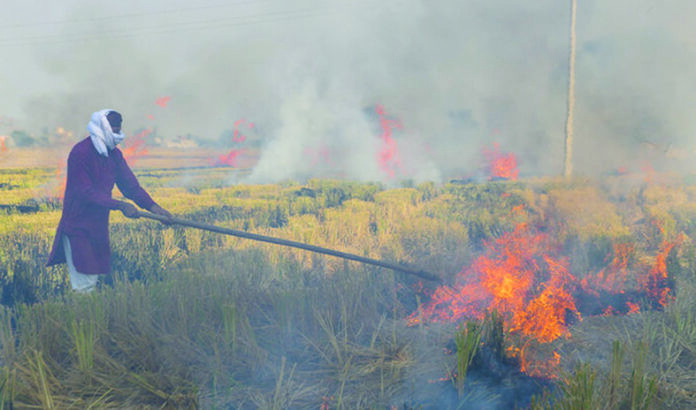
With the advancing harvest season of Kharif crops, the government authorities have escalated their efforts to mitigate the annual smog crisis in Pakistan. The Punjab government is mulling over a four-day work week to counter smog. This plan is a reflection of last year’s policy, whereby schools were closed for three days a week for the same reason. Though such measures are required to alleviate health and safety hazards; they will not address the root cause of the menace which has profound implications on the socio-economic structure of not only Punjab, but the entire country.
According to the Food and Agriculture Organisation, Pakistan produces around 69 million tons of stubble annually, which contributes to 20 percent of air pollution. Stubble burning augments black carbon emission, causing smog, especially in colder weather. It brings down work productivity and causes health problems. The World Bank finds that smog costs Pakistan approximately 6.5 percent of its GDP annually and 22,000 premature adult deaths. To cope with the smog crisis, the Punjab government had declared an environmental emergency in 2022 and expedited the implementation of the Punjab Clean Air Action Plan 2019, which is but a drop in the bucket compared to the harrowing situation of smog in Pakistan.
Under the Punjab Clean Air Action Plan, a three-step policy was introduced. In the first step, measures to discourage stubble burning were introduced along with alternate farming practices. In the second step, legislative actions were suggested to demarcate air pollution control areas and install emission control systems. The third step was focused on capacity building. Although the action plan was comprehensive, it failed to eliminate smog.
Stubble burning is still being practiced all over Punjab which contributes to 60 percent of agriculture in Pakistan. To act upon alternate farming measures, the Punjab government has distributed 500 Happy Seeders – a planter that shreds crop residue and mulches it into the soil. The equipment has the potential to reduce carbon emissions by 78 percent. However, owing to the huge amount of crop residue, the number of machines distributed could not meet the demand. They were also provided for the ‘red zone’ only and the cost of the machine is beyond the buying capacity of small farmers. To discourage stubble burning, the government of Punjab has also penalised it with a fine of Rs 50,000 per acre. However, the penalty failed to work due to a lack of enforcement and the absence of alternative technology.
Though provincial governments, especially Punjab, are taking plausible measures; without drafting a road map to nip the root cause, the annual smog crisis will continue to haunt the country. Instead of taking short-term measures and imposing environmental emergencies, the stakeholders need to work towards long term structural and technological reforms.
Keeping in view these policy backdrops and the surging smog crisis, the stakeholders need to take long-term structural and technological reforms. The foremost policy measure could be setting up an apparatus for biomass plants. As stated, Pakistan is annually producing 69 million tons of crop residue. At the same time, Pakistan is facing an energy crisis due to costly non-renewable energy sources.
Pakistan could turn this bane into a boon by setting up biomass plants in rural areas that could use the crop residue to provide fuel for agricultural and domestic purposes. To set up biomass plants the biggest hurdle is the lack of finance. To cope with this problem, the government could start public-private partnership programmes through which private companies could set up plants in return for getting tax relaxations. Those farmers who provide crop residues to the plants could also be given customised subsidies on seeds and electricity bills.
Secondly, the provincial governments need policies on solid waste disposal of crop residues. Compositing and incineration technologies could be introduced according to the region. For fertile and populous areas composting could be used to manage organic waste as it turns crop residues into an organic conditioner for the soil. Subsequently, as Pakistan has 1.89 million hectares of saline land, incineration technology could be introduced in these unused saline regions.
Lastly, subsidised mulch chippers and happy shedders should be distributed by the government. The government of Punjab took the initiative to subsidise 500 happy shedders. It was a constructive pilot project and needs to be adopted by other provinces. Although Punjab is the major contributor of black carbon, Sindh and KPK governments should also adopt anti-smog policies as the smog crisis is a national issue and requires collective effort from all the stakeholders.
Though provincial governments, especially Punjab, are taking plausible measures; without drafting a road map to nip the root cause, the annual smog crisis will continue to haunt the country. Instead of taking short-term measures and imposing environmental emergencies, the stakeholders need to work towards long term structural and technological reforms.






